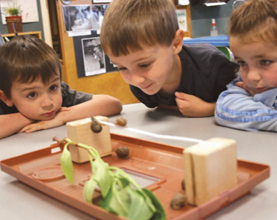4.15: Partnering with Caregivers
As the snail-exploration vignette illustrates in several places, teachers also include the children’s caregivers in supporting children’s learning. Teachers find it particularly helpful to share documentation of children’s learning with children’s family members. When caregivers and teachers reflect together on documentation of children’s play and learning, family members offer insights into the children’s behavior and ideas, as well as share expectations of their children at home or in the community. Teachers also provide resources to caregivers to bridge children’s experiences in preschool with experiences at home and in the community. For example, the teachers used the children’s interest in snails to support family members’ participation in creating learning opportunities in the following way:
During the snail exploration, teachers posted near the entry a note with a photo of children exploring snails at the science table.

They suggested that caregivers consider doing a snail hunt on the way to school, in a park, or in a yard. A stack of copies of the snail diagram with the words eyes, tentacles, and shell written in Spanish, English, and Russian was available for family members to take with them.[2]
References
[1] Image by the California Department of Education is used with permission
[2] California Preschool Curriculum Framework, Volume 1 by the California Department of Education is used with permission

Feedback/Errata